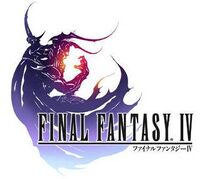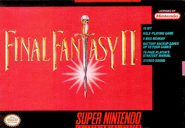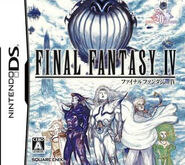Không có tóm lược sửa đổi |
Không có tóm lược sửa đổi |
||
| Dòng 4: | Dòng 4: | ||
|japan = ファイナルファンタジーIV |
|japan = ファイナルファンタジーIV |
||
|romaji = Fainaru Fantajī IV |
|romaji = Fainaru Fantajī IV |
||
| − | |developer = ''''' |
+ | |developer = '''''Phiên bản SNES:''''' |
:[[Square Co., Ltd.]] |
:[[Square Co., Ltd.]] |
||
| − | '''''Nintendo DS |
+ | '''''Phiên bản Nintendo DS:''''' |
:[[Matrix Software]] |
:[[Matrix Software]] |
||
|publisher = <div style="white-space: nowrap;">[[File:Flag of Japan.svg|20px|Japan]] [[Square Co., Ltd.]]<br />[[File:Flag of the United States.svg|20px|United States]]/[[File:Flag of Canada.svg|20px|Canada]] [[Square Co., Ltd.|Square Soft, Inc.]]</div> |
|publisher = <div style="white-space: nowrap;">[[File:Flag of Japan.svg|20px|Japan]] [[Square Co., Ltd.]]<br />[[File:Flag of the United States.svg|20px|United States]]/[[File:Flag of Canada.svg|20px|Canada]] [[Square Co., Ltd.|Square Soft, Inc.]]</div> |
||
| − | |release = <div style="white-space: nowrap;">''''' |
+ | |release = <div style="white-space: nowrap;">'''''Hệ máy SNES:''''' |
:[[File:Flag of Japan.svg|20px|Japan]] April 19, 1991 (''Hard Type'') |
:[[File:Flag of Japan.svg|20px|Japan]] April 19, 1991 (''Hard Type'') |
||
:[[File:Flag of Japan.svg|20px|Japan]] October 19, 1991 (''Easy Type'') |
:[[File:Flag of Japan.svg|20px|Japan]] October 19, 1991 (''Easy Type'') |
||
:[[File:Flag of the United States.svg|20px|United States]]/[[File:Flag of Canada.svg|20px|Canada]] November 23, 1991 |
:[[File:Flag of the United States.svg|20px|United States]]/[[File:Flag of Canada.svg|20px|Canada]] November 23, 1991 |
||
| − | ''''' |
+ | '''''Hệ máy PlayStation:''''' |
:[[File:Flag of Japan.svg|20px|Japan]] March 21, 1997 |
:[[File:Flag of Japan.svg|20px|Japan]] March 21, 1997 |
||
:[[Image:Flag of the United States.svg|20px|United States]]/[[Image:Flag of Canada.svg|20px|Canada]] June 29, 2001 |
:[[Image:Flag of the United States.svg|20px|United States]]/[[Image:Flag of Canada.svg|20px|Canada]] June 29, 2001 |
||
| Dòng 19: | Dòng 19: | ||
'''''WonderSwan Color version:''''' |
'''''WonderSwan Color version:''''' |
||
:[[File:Flag of Japan.svg|20px|Japan]] March 28, 2002 |
:[[File:Flag of Japan.svg|20px|Japan]] March 28, 2002 |
||
| − | '''''Game Boy Advance |
+ | '''''Hệ máy Game Boy Advance:''''' |
:[[File:Flag of Japan.svg|20px|Japan]] December 15, 2005 |
:[[File:Flag of Japan.svg|20px|Japan]] December 15, 2005 |
||
:[[File:Flag of the United States.svg|20px|United States]]/[[File:Flag of Canada.svg|20px|Canada]] December 12, 2005 |
:[[File:Flag of the United States.svg|20px|United States]]/[[File:Flag of Canada.svg|20px|Canada]] December 12, 2005 |
||
:[[File:European flag.svg|20px|Europe]] June 2, 2006 |
:[[File:European flag.svg|20px|Europe]] June 2, 2006 |
||
:[[File:Flag of Australia.svg|20px|Australia]] February 23, 2006 |
:[[File:Flag of Australia.svg|20px|Australia]] February 23, 2006 |
||
| − | '''''Nintendo DS |
+ | '''''Hệ máy Nintendo DS:''''' |
:[[File:Flag of Japan.svg|20px|Japan]] December 20, 2007 |
:[[File:Flag of Japan.svg|20px|Japan]] December 20, 2007 |
||
:[[File:Flag of the United States.svg|20px|United States]]/[[File:Flag of Canada.svg|20px|Canada]] July 22, 2008 |
:[[File:Flag of the United States.svg|20px|United States]]/[[File:Flag of Canada.svg|20px|Canada]] July 22, 2008 |
||
Phiên bản lúc 02:12, ngày 16 tháng 7 năm 2010
| Final Fantasy IV | |

| |
| ファイナルファンタジーIV Fainaru Fantajī IV | |
| Phát triển: | Phiên bản SNES:
Phiên bản Nintendo DS:
|
| Phát hành: | |
| Ngày phát hành: | Hệ máy SNES:
Hệ máy PlayStation: WonderSwan Color version: Hệ máy Game Boy Advance: Hệ máy Nintendo DS: Wii Virtual Console: Mobile phones: |
| Thể loại: | Role-playing game |
| Chế độ chơi: | Single player, Multiplayer (PlayStation) |
| Phân loại: | PlayStation: ESRB: |
| Hệ máy: | SNES, PlayStation, WonderSwan Color, Game Boy Advance, Nintendo DS |
Final Fantasy IV is the fourth game in the Final Fantasy series. Originally released for the Super Nintendo Entertainment System, the game was subsequently re-released for the PlayStation, the WonderSwan Color, the Game Boy Advance and the Nintendo DS. It was originally released in North America as Final Fantasy II. This altered numbering system caused the game Final Fantasy VI to be numbered Final Fantasy III, leading to quite a bit of confusion when the PlayStation game Final Fantasy VII (which retained the number VII) came out. A sequel, Final Fantasy IV: The After Years, was released for Japanese mobile phones in February 2008. The sequel was released via WiiWare in the US on June 1, 2009.
Gameplay

A battle scene from the original Japanese version of the game.
Gameplay in Final Fantasy IV is standard computer role-playing game fare; characters traverse an overworld to fulfill requirements of various quests, using towns to replenish strength, buy new equipment, and discover clues, all the while fighting monsters at random intervals. The game also introduces Square's Active Time Battle (ATB) system, which differs from previous Final Fantasy games (and from most RPGs in general) in that players must give orders to their characters in real-time. The ATB system would appear again in the next five games in the series, as well as making appearances in other games produced by Square, including Chrono Trigger and Final Fantasy X-2.
In battle, each character has certain strengths and weaknesses, including either spellcasting powers or other special abilities, based on their job. Like other Final Fantasy games, characters gain in abilities as they gain experience from battles. Magic is divided into four different categories, which include White Magic, Black Magic, Rydia's Summon Magic (Call in the SNES version), and a special type of offensive and support magic used exclusively by Edge known as Ninjutsu.
Of note is the extensive use of "retort" attacks that the enemies use. This makes it so that if all five of your characters attack an enemy with this retort ability then the enemy will respond with five of its own attacks. An example is the Behemoth. This overused method was not repeated as extensively in later FF games. This leads to much shuffling of characters to find one that is either able to kill the enemy in one blow, thereby killing the opponent before it can retort, or at least find a character that has a worthwhile melee attack.
Character shuffling was also a major problem in the game. You could literally cycle through the entire party twice before having the ability to select a specific character that you wanted to use. This shuffling was not necessarily caused by the ATB gauge; even with the character's gauge full, you could still cycle through the party twice before being able to use the character.
Spellcasters, which account for eight of the twelve playable characters (Kain, Edward, Yang and Cid cannot use magic), gain magic spells at preprogrammed experience levels or fixed events in the story; for this reason Final Fantasy IV's ability development system is considered the simplest of any game in the series. This makes it very similar to the way Clerics gain spells in Dungeons & Dragons, as opposed to the purchasing of spells in the original FF, which is closer to the way mages buy spells in D&D.
Unlike the original Final Fantasy, almost no time is needed to gain enough levels/experience to advance to the next area of the game. It is more evenly paced out so that the player can simply go to the next area as long as the party does not escape from the majority of random encounters.
Story

The playable cast of Final Fantasy IV, excluding Fusoya.
The most powerful nation in the world, the Empire of Baron, begins utilizing its unparalleled air force, the Red Wings, and its legions of Dark Knights to attack peaceful nations in search of four Crystals, each corresponding to a different classical element. Cecil Harvey, a Dark Knight and leader of the Red Wings, begins to question the king's motives after forcibly stealing the Water Crystal from the wizards' town of Mysidia. Upon questioning the king, Cecil falls from grace and is stripped of his rank and sent, along with his friend, the Dragoon Kain Highwind, to deliver a package to the Village of Mist. Prior to setting out on his quest, Cecil receives emotional support from White Mage Rosa Joanna Farrell, his life-long friend whose feelings for him have grown beyond mere friendship, and Cid Pollendina, Baron's airship engineer and father-figure to Cecil. Upon reaching Mist, the explosives in the package destroy the entire town and kill most of its inhabitants.Cecil and Kain find a young female survivor named Rydia. Cecil decides to take her with them but Rydia summons Titan and Kain is no-where to be found. Cecil, now angered with Baron and the Red Wings, initiates a quest to stop them. On his journey back to Baron, Cecil encounters Rosa stricken with Desert Fever; an elderly wizard, Tellah; the cowardly and emotional prince of Damcyan, Edward Chris von Muir; and the powerful Monk of Fabul, Yang Fang Leiden. Cecil also encounters Kain, who is proceeding with the theft of the remainder of the crystals for Baron. He is followed shortly after by a man named Golbez because Kain was not able to kill Cecil. During a skirmish, Rosa is kidnapped by Golbez. The party soon discovers that Golbez is manipulating Kain and Baron's Emperor in order to retrieve the Crystals. After a ship attack by the sea monster Leviathan, Cecil becomes stranded near Mysidia, where he is forced to repent for his previous crimes by becoming a holy Paladin. It is here that he also meets the apprentice mages Palom and Porom, who guide and monitor him along his journey up Mt. Ordeals. They are joined by Tellah, who seeks the power of Meteor, and after battling fiend of earth Scarmiglione twice, Cecil overcomes his darkness and becomes a Paladin. Tellah also remembers his spells and learns Meteor, which he cannot yet use.
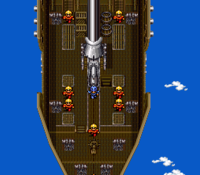
Final Fantasy IV Intro.
After Cecil attains Paladin status, the party invades Baron via the Devil's Road. However, Golbez has manipulated the soldiers of Baron, and even replaced the king with Cagnazzo, fiend of water, whom Cecil and company destroy. Cid manages to escape his cell sometime during this incident, and after the twins intentionally petrify themselves to stop a deathtrap, the party takes to the skies in Cid's airship. Cecil soon encounters the brainwashed Kain, who forces Cecil to retrieve the Crystal of Earth in exchange for the life of Rosa. After Cecil and company retrieve the crystal from the Dark Elf, Kain leads the group to the Tower of Zot, where Rosa is being held by Golbez. Upon facing Golbez directly, Tellah seizes the moment and attacks him with Meteor, the use of which kills Tellah, but which injures, though does not kill Golbez, causing him to retreat to heal. Seemingly as a result of Golbez's injuries, the mind control on Kain is shattered, and he explains that Golbez has not retrieved all of the Crystals; four more, called the Dark Crystals, are hidden in the underground land of the Dwarves, and Golbez has already stolen two of them. The party rescues Rosa, and after destroying Barbariccia, fiend of wind, they unlock a path to the underground and seek the Dark Crystals.
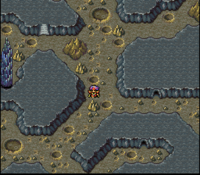
On the Moon.
Cecil and company chase Golbez into the Dark World, and attempt to capture the crystals before Golbez does. However, they lose one in battle against Golbez in the Dwarven Castle, after which Rydia rejoins the party. Later, after the Tower of Babil, the apparent sacrifices of Yang and Cid, after the Ninja prince of Eblan, Edge joins the party and helps them defeat Rubicante, Cecil's party again comes up short; Golbez apprehends the remaining crystal, by reasserting his mind control over Kain, who steals the last Crystal from Cecil and runs off. Golbez then retreats to the planet's second moon. In order to discover what plan Golbez has for the Crystals and hopefully to stop it, Cecil follows Golbez to the second moon using the ancient starship the "Lunar Whale" hidden in Mysidia's bay.
On the moon, Cecil meets FuSoYa, who explains to him that he is descended from a race known as the Lunarians, who originated on a planet that was destroyed to form an asteroid belt. Cecil's father, KluYa, was responsible for storing the Crystals, which correspond to Crystals on the moon that hold the thoughts of the Lunarians, on the planet and introducing technological advances such as the airship. However, one Lunarian, Zemus, plans to wipe out all life on the planet for Lunarian inhabitation. It is revealed that Zemus is manipulating Golbez and Kain, and that he plans to use the Crystals to revive a giant android, the Giant of Babil, and clear the planet for this purpose.

A CG picture of the cast of the DS version of Final Fantasy IV, excluding Cid, Tellah and FuSoYa.
Accompanied by FuSoYa, who can neutralize the Giant of Babil's force field, Cecil returns to the planet to find the Giant revived. The entire world- including former party members Edward, Cid, Yang, and the twins Palom and Porom- participates in the attack. After using Cid's airship to break into the Giant, the party defeats the Archfiends working in tandem, and destroys the CPU. Upon stopping the giant, the party is confronted by Golbez, intent on destroying them. FuSoYa is able to break Zemus's control over Golbez and Kain. In the scenes that follow, Cecil discovers that Golbez is actually his brother. Golbez and FuSoYa head to the moon to attempt to defeat Zemus, and Cecil's party follows. After fighting his way to the core of the moon, Cecil watches Golbez and FuSoYa defeat Zemus, only to discover that his death unleashed a more powerful being named Zeromus, the personification of Zemus' pure hatred. Zeromus easily defeats Golbez and FuSoYa, then attacks the rest of Cecil's party. It takes the united life force of all beings, combined with a special Crystal provided by Golbez, for Cecil and his party to defeat Zeromus.
After Zeromus's defeat, FuSoYa returns to sleep with the rest of his people. Golbez, feeling that he cannot return to the earth after what he has done, and being half Lunarian himself, goes with him. Before he does, Cecil forgives him and calls him brother. Later, the moon heads off into space, and many of the characters return to their homes, several in order to rebuild them. Kain goes to Mount Ordeals to train himself, vowing not to return to Baron until he has proven himself worthy. The important characters in the game (excluding Kain) attend Cecil and Rosa's wedding, as Cecil becomes King of Baron
Development
- Xem thêm: Final Fantasy IV/Version Differences.
Final Fantasy IV was released in a variety of different versions for a variety of different platforms. All versions tell the same story, and feature the same characters. Most use the same graphics, sound, music, and basic game engine (the DS version being a notable exception). Nonetheless, there are certain key distinctions between each version.
Because of the extreme differences between this North American SNES version of the game and the original Japanese release, in the late 1990s, J2e Translations released an English language fan translation of the original game.
Easytype
The original Final Fantasy IV was altered in several regards in order to reduce the difficulty level for Final Fantasy IV Easytype. Various spells, abilities and items were removed or altered, shop prices were lowered, and other tweaks to make the game easy were put in place. It is often thought that the original North American translation was a translation of easytype, but the translated version was developed before easytype, and the difficulty is further reduced in easytype than in the North American version. This leads to speculation that Easytype was based off of the North American Final Fantasy II rather than vice-versa, as some circles to this day believe.
Final Fantasy II (North America)

Original SNES Logo for Final Fantasy II.
Final Fantasy IV Easytype is roughly similar to the game released in North America, but the game lost some content to censorship and poor translation when localized. References to religious imagery and names were removed, violence and death were toned down or removed entirely, and various names were changed in all aspects of the game.
PlayStation
The PlayStation re-release is mostly identical to the original version of Final Fantasy IV. Some minor tweaks introduced in Final Fantasy IV Easytype have been left in, but these are so rare that the average gamer could very easily play through the entire game and never notice them. The most notable change in the PlayStation release is the inclusion of a full motion video opening sequence, the ability to "run" in dungeons and towns by holding the Cancel button, and the ability to perform a "memo" save anywhere on the world map. This save would remain active in the PlayStation's RAM until it was overwritten by another such save, or the power was turned off or interrupted.
The North American and European localization of Final Fantasy IV PlayStation featured an entirely rewritten translation which addressed most of the discrepancies between the original game and the SNES Final Fantasy II. However, certain sections, such as the line "You spoony bard!", were kept intact, as many of them had achieved cult status.
WonderSwan Color
The WonderSwan Color version of Final Fantasy IV lacked the FMVs of the PlayStation version, had decreased screen resolution, and down sampled music and sound effects to meet the specifications of the device.
However, a number of graphical enhancements were made to character sprites and backgrounds by providing additional details and color shading. The original character portraits were replaced with new, smaller portraits. Also, certain boss sprites were changed to those featured in the Japanese Easytype version of the Super Famicom game.
The game also featured revamped difficulty that is different from both the original and the Easytype versions of the game.
Game Boy Advance
The Game Boy Advance port of the game was released in North America on December 12, 2005, while the Japanese version was released on December 15, 2005. The Japanese version also came with a bonus addition of a themed face plate for the Game Boy Micro which features Amano artwork of Cecil and Kain. The game is largely based on the WonderSwan Color version of the game. Some changes include the addition of character portraits in text boxes, the ability to switch party members, increased difficulty, and new dungeons with new items and weapons along with new bosses. The script also received a retranslation more faithful to the original material. The Quicksave, which allows the player to save the current position (regardless of where) in a file that is deleted upon loading, was featured.
However, some minor bugs were introduced into the game, notably in the battle system, possibly as a result of merely porting the game from an existing platform instead of fully optimizing the game for the GBA hardware. Examples would include party members' turns being skipped and randomly being given two (or, less frequently, more) turns in a row straight for a single character (for instance, Edge might attack a monster, and once he has, he'll instantly be given another chance to act without waiting for his time gauge to fill up). There is also some jerkiness while flying airships (more so when going left and right than up and down) and during menu navigation (in and out of battle). The latter makes it less effective to select spells or weapons during fast-paced Active Mode battles. Furthermore, some very minor "artistic license" was taken with the soundtrack (the Tower of Babil and Sylph Cave/Summoned Monster Cave themes each have one altered note). Also, minor lag during boss battles is present.
These are heavily present in the original release of Final Fantasy IV Advance; however, in Japan, a second version of the game was released which corrected most, if not all, of the bugs and problems. The European version of the game was derived from the second Japanese version, which makes it the only English release of that version.
Nintendo DS
Final Fantasy IV was released for the Nintendo DS as part of the Final Fantasy 20th Anniversary campaign. The game is developed by Matrix Software, the same team responsible for the Final Fantasy III remake, and was supervised by members of the original development team: Takashi Tokita serves as executive producer, Tomoya Asano as producer, Hiroyuki Itō as battle designer. Animator Yoshinori Kanada story boarded the new cutscenes. This game was released in North America on 22 July, 2008.

A battle in the DS port.
According to executive producer Takashi Tokita (Scenario writer of the original release), 3/4 of the original script had been cut from Super Famicom original release, but some of this lost material was reworked into the remake, while some new events were added. The player has the ability to use the Nintendo DS stylus to move around similarly to the Final Fantasy III remake, while the new mini games require usage of the stylus. Additionally, the game features an ability system which should add replayability to the game, as well as a New Game Plus feature and the Quicksave, which allows the player to save the current position (regardless of where) in a file that is deleted upon loading.
In June 2007, Square Enix held a casting for a vocalist to sing a version of Final Fantasy IV's "Theme of Love" rearranged by Nobuo Uematsu. It also used a voice cast for the game's cinematic sequences. Some changes and additions to the Nintendo DS release include the introduction of a new ability system called Augments, increased difficulty level with new enemy attack scripts and increased enemy stats, changes to the equipment system, the summon Whyt which makes use of the DS touch screen, and the aforementioned New Game Plus.
Mobile phones

A battle in the Mobile version.
Final Fantasy IV was ported to Japanese mobile phones on October 5th, 2009. The game uses all-new character graphics during and outside of battle, with some taken from The After Years. As The After Years was based on the Advance engine, this version is also influenced by Final Fantasy IV Advance. This new version incorporates the party-switching feature, and has another post-game bonus "EX Dungeon", which is a remake of the Lunar Ruins.
Packaging Artwork
Trivia
- The names of the Archfiends (Scarmiglione, Cagnazzo, Barbariccia, and Rubicante) are references to four demons mentioned in Canto 21 of Dante Alighieri's Inferno. Another boss in the game, Calcabrina, also draws its name from the same passage.
- Both Final Fantasy II and Final Fantasy IV contain a town of magic users called Mysidia.
- The Game Boy Advance version includes the Easytype sprite of Zeromus as a boss at the end of the Lunar Ruins. It has the title "Zeromus EG", most likely standing for "Easy Game" or "iiji" (the phonetic sound of the word easy as pronounced in Japanese).
- Final Fantasy IV is the first game of the series that uses Save Points and the ATB (Active Time Battle) system.
- In the DS version, there is a possible glitch involving the event viewer. After viewing a certain movie, the game will sometimes freeze up at the final FMV and players can not access New Game +.
- Although its sequel, Final Fantasy IV: The After Years, is visually similar to the classic 2D versions of the game, it follows after the slightly altered continuity established in the DS version.
- It is one of the Final Fantasy games that has been novelized in Japan.
- The Boss Theme of Final Fantasy IV was slightly remixed and used as the Culex Boss Theme in Super Mario RPG: Legend of the Seven Stars. In fact, Culex himself was purposely based off a boss that would be typical in the Final Fantasy series.
- Oddly enough, Final Fantasy IV is the first game in the series in which four isn't the maximum capacity for the player's party.
External link
- Final Fantasy IV Advance Official Site (Japanese)
- Final Fantasy IV DS Official Site (Japanese)
- Final Fantasy IV DS (North American)
- Wikipedia's entry on Final Fantasy IV
- Final Fantasy IV SNES Sprites
| v · e · d Final Fantasy IV
|
|---|
| Nhân Vật |
|
Nhân vật chơi được |
|
Nhân vật không chơi được |
| Địa Danh |
|
Overworld Underworld The Red Moon |
| Chủng Tộc |
| Hummingway - Lunarians - Dwarves - Summoner |
| Khái Niệm - Thuật Ngữ |
| Archfiends - Augment Ability - Carnelian Signet - Crystal - Eidolon - Eight Corps of Baron - Enterprise - Falcon - Giant of Babil - Hovercraft - Lunar Sleep - Lunar Whale - Meteor - Mysidian Legend - Mythgraven Blade - Red Wings - Super Cannon - Tank - Thought Bubble - Wayfarer's Map - You Spoony Bard! |
| Âm Nhạc |
| Original Sound Version - Celtic Moon - Piano Collections - Minimum Album - Music from Final Fantasy Chronicles - Tsukino Akari -Final Fantasy IV Ai no Theme- - Final Fantasy Finest Box - Original Soundtrack |
| "Main Theme" - "Theme of Love" - "Four Archfiends" - "Zeromus" |
| Dữ Liệu Lưu Trữ |
| Abilities - Armor - Bugs and Glitches - Enemies - Enemy Abilities - Items - Spells - Translations - Version Differences - Walkthroughs - Wallpapers - Weapons |
v · e · d Finest Fantasy for Advance Finest Fantasy for Advance  |
|---|
| Final Fantasy I & II: Dawn of Souls — Final Fantasy IV — Final Fantasy V — Final Fantasy VI |
v · e · d  Final Fantasy 20th Anniversary Final Fantasy 20th Anniversary  |
|---|
| Final Fantasy — Final Fantasy II — Final Fantasy IV — Dissidia Final Fantasy |



